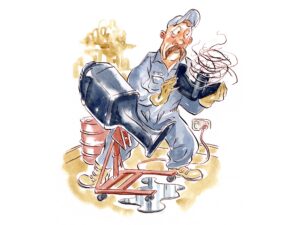A cruiser once expertly spun his boat into the tight space at the gas dock, except he forgot he had his dinghy dragging behind. The tow rope came taut on the swing, and like a whipped tuber, the little tender gained momentum and ricocheted off the dock. Thankfully, nothing got damaged, other than the owner’s pride. Taking proper care of your dinghy is as much a part of seamanship as manning the helm of your cruiser. Here are a few tips for tender loving care.
Storing It
An easy solution for smaller cruisers is to attach the tender to the swim platform, either by transom clips or stern davits. The drawbacks to either method are that you lose use of the swim platform unless you remove the tender, and you have to remove the outboard engine and store it on deck. (Never store a tender’s outboard belowdecks; it could emit gas vapors.)
If your boat’s big enough, you can mount the dinghy on the bow with the engine attached. This requires adding chocks and either a davit or electric crane to remove the tender. It could also restrict your line of sight from the helm, require electrical installation and be more difficult to deploy into the water and board.
Towing It
Another option many choose is to tow it. You’re going to need to use a bridle. Install heavy-duty, stainless-steel D-rings on either side of the dinghy’s bow to handle the tow rope. Use at least a three-eighths-inch line. Create a Y by tying a bowline in the end of the tow line, and then tie two other lengths of line to the loop. Attach the tag ends of the Y to each D-ring so that the pulling load is evenly distributed. Create a Y at the other end of the tow line and attach it to the stern of your boat. You can slip a float over the line to help keep the line, your “hawser,” clear of the propellers.
Make sure the dinghy rides in the dead center of the V-wake behind your boat and is sitting on the back of one of your wake’s waves. Adjust the setup so that the dinghy and boat are in sync with the seas — that is, it crests waves at the same time. It’s good to have catenary, or “droop,” in the line to lessen shocks. If your dinghy wanders, attach the tow line lower on its stem, which raises the bow and inhibits “rooting.”
When you come to the marina or, ahem, the fuel dock, pull the tow line in and lash the bow right to the transom to keep the tender’s movements in sync with the main vessel’s. Maybe your tender can bounce too, but you don’t want to find out.









